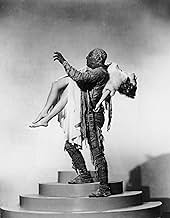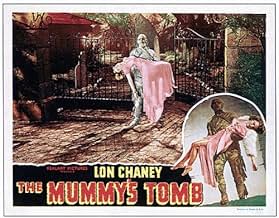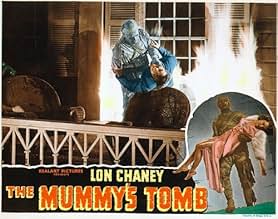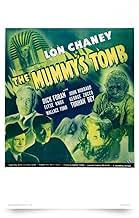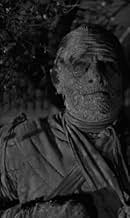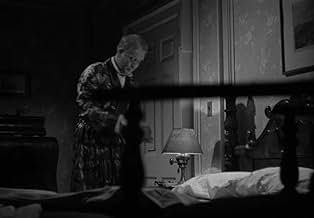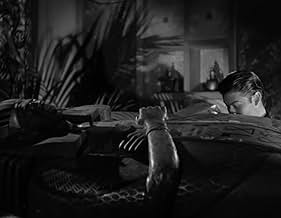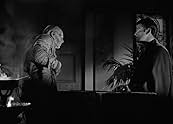NOTE IMDb
5,5/10
4,2 k
MA NOTE
La momie de l'Égypte ancienne, Kharis, est transportée de sa patrie avec le grand prêtre Mehemet pour se venger de la famille qui a souillé la tombe sacrée de sa princesse bien-aimée Ananka.La momie de l'Égypte ancienne, Kharis, est transportée de sa patrie avec le grand prêtre Mehemet pour se venger de la famille qui a souillé la tombe sacrée de sa princesse bien-aimée Ananka.La momie de l'Égypte ancienne, Kharis, est transportée de sa patrie avec le grand prêtre Mehemet pour se venger de la famille qui a souillé la tombe sacrée de sa princesse bien-aimée Ananka.
- Réalisation
- Scénario
- Casting principal
- Récompenses
- 1 nomination au total
Lon Chaney Jr.
- The Mummy - Kharis
- (as Lon Chaney)
Sig Arno
- The Beggar
- (images d'archives)
- (non crédité)
Brandon Beach
- Reporter
- (non crédité)
Leon Belasco
- Ali
- (images d'archives)
- (non crédité)
Walter Byron
- Searcher
- (non crédité)
Noble 'Kid' Chissell
- Townsman
- (non crédité)
Avis à la une
THE MUMMY'S TOMB (Universal, 1942), directed by Harold Young, the third installment in the Mummy series, the second to feature Kharis and the first starring Lon Chaney Jr. as the living creature under wraps. A sequel to THE MUMMY'S HAND (1940) released two years earlier, this legend of Kharis continues, set thirty years later, with Dick Foran, Wallace Ford and George Zucco reprising their original characters sporting middle-age makeup consisting of gray hairs, glasses and wrinkles.
The story opens in a town of Mapleton in Massachusetts, with the middle-aged widow named Steve Banning (Dick Foran) relating his scientific expedition to his sister, Jane (Mary Gordon), son, John (John Hubbard) and Isobel (Elyse Knox), John's fiancé, on how he, his now deceased wife, Marta (played earlier by Peggy Moran) and his friend, Babe Hanson (Wallace Ford) encountered the ancient burial ground of Kharis, the mummy. The next scene shifts over to Egypt where High Priest Andoheb (George Zucco), who amazingly survived three bullet wounds shot into him by Hansen and his long plunge down the temple steps (told via flashback), assigns Mehemet (Turhan Bey), to guide Kharis (Lon Chaney Jr.) to America where his next assignment is to avenge the surviving members of the expedition, doing away with the Banning family and finally Babe Hansen, whose character arrives later in the story.
Taking a new direction from its previous successors by shifting Kharis from Egypt to the United States, with similarities to Dracula (1931) where Kharis on board the ship, resting inside his tomb, bound for his destination with Mehemet as his guide in the similar fashion to Dracula's Mr. Renfield. Once in Massachusetts, Mehemet takes up residence as a cemetery caretaker with Kharis feeling right at home surrounded by tomb sweet tombs of buried beings. Like Dracula, Kharis stalks his victims at night and rests by day.
While THE MUMMY'S TOMB tends to be original, it mostly borrows from other horror stories, including its predecessor where Mehemet captures Isobel to make her his bride as his predecessor Andoheb tried to do with Marta in THE MUMMY'S HAND. Besides resurrections and revisions, the film delivers towards its final half with chills and thrills, and Kharis meeting the same fate as the Frankenstein monster, who doesn't appear here.
Supporting players include Frank Reicher (Professor Matthew Norman); Cliff Clark (The Sheriff); Virginia Brissac (Ella Evans); and Otto Hoffman (The Cemetery Caretaker).
Strictly "B" material for the juvenile crowd, THE MUMMY'S TOMB is a fast-paced if not entirely incredible 62 minutes. Without the flashback and stock material from the previous film, this movie would have been ten minutes shorter. Minus the over abundance of comedy relief stressed out from THE MUMMY'S HAND, TOMB has all the familiarities from other Universal horror films from the 1940s, especially the stock musical score by Hans J. Salter. Although THE MUMMY'S TOMB did not become a top of the line Mummy show, it did lead the way to the next installment of THE MUMMY'S GHOST (1944), considered by many to be the best of all the "Kharis" thrillers.
Footnote: For anyone paying close attention to detail, it should be noted that since the first Kharis film installment obviously takes place in 1940, then this sequel, which looks very much like modern-day 1942, is set thirty years into the future, namely 1970. Otherwise if this is 1942, then the earlier film should have taken place in 1912 with actors in futuristic 1940s attire.
Other than local television presentations prior to 1985s Fright Night/Chiller theaters, and availability on video cassette and later DVD format, it's cable broadcast history consists of the Sci-Fi Channel (1990s) and American Movie Classics (2000-2002).(**)
The story opens in a town of Mapleton in Massachusetts, with the middle-aged widow named Steve Banning (Dick Foran) relating his scientific expedition to his sister, Jane (Mary Gordon), son, John (John Hubbard) and Isobel (Elyse Knox), John's fiancé, on how he, his now deceased wife, Marta (played earlier by Peggy Moran) and his friend, Babe Hanson (Wallace Ford) encountered the ancient burial ground of Kharis, the mummy. The next scene shifts over to Egypt where High Priest Andoheb (George Zucco), who amazingly survived three bullet wounds shot into him by Hansen and his long plunge down the temple steps (told via flashback), assigns Mehemet (Turhan Bey), to guide Kharis (Lon Chaney Jr.) to America where his next assignment is to avenge the surviving members of the expedition, doing away with the Banning family and finally Babe Hansen, whose character arrives later in the story.
Taking a new direction from its previous successors by shifting Kharis from Egypt to the United States, with similarities to Dracula (1931) where Kharis on board the ship, resting inside his tomb, bound for his destination with Mehemet as his guide in the similar fashion to Dracula's Mr. Renfield. Once in Massachusetts, Mehemet takes up residence as a cemetery caretaker with Kharis feeling right at home surrounded by tomb sweet tombs of buried beings. Like Dracula, Kharis stalks his victims at night and rests by day.
While THE MUMMY'S TOMB tends to be original, it mostly borrows from other horror stories, including its predecessor where Mehemet captures Isobel to make her his bride as his predecessor Andoheb tried to do with Marta in THE MUMMY'S HAND. Besides resurrections and revisions, the film delivers towards its final half with chills and thrills, and Kharis meeting the same fate as the Frankenstein monster, who doesn't appear here.
Supporting players include Frank Reicher (Professor Matthew Norman); Cliff Clark (The Sheriff); Virginia Brissac (Ella Evans); and Otto Hoffman (The Cemetery Caretaker).
Strictly "B" material for the juvenile crowd, THE MUMMY'S TOMB is a fast-paced if not entirely incredible 62 minutes. Without the flashback and stock material from the previous film, this movie would have been ten minutes shorter. Minus the over abundance of comedy relief stressed out from THE MUMMY'S HAND, TOMB has all the familiarities from other Universal horror films from the 1940s, especially the stock musical score by Hans J. Salter. Although THE MUMMY'S TOMB did not become a top of the line Mummy show, it did lead the way to the next installment of THE MUMMY'S GHOST (1944), considered by many to be the best of all the "Kharis" thrillers.
Footnote: For anyone paying close attention to detail, it should be noted that since the first Kharis film installment obviously takes place in 1940, then this sequel, which looks very much like modern-day 1942, is set thirty years into the future, namely 1970. Otherwise if this is 1942, then the earlier film should have taken place in 1912 with actors in futuristic 1940s attire.
Other than local television presentations prior to 1985s Fright Night/Chiller theaters, and availability on video cassette and later DVD format, it's cable broadcast history consists of the Sci-Fi Channel (1990s) and American Movie Classics (2000-2002).(**)
As Dick Foran and Wallace Ford put the torch to Kharis the Mummy in The Mummy's Hand there's no way that Universal Pictures was thinking about a sequel. Otherwise they would have made sure to identify the fact that the action was taking place in 1912 and had everyone wear costumes of the period.
So it looks a little ridiculous to have Dick Foran and Wallace Ford now elderly beginning The Mummy's Tomb made up as elderly gents with Foran reminiscing about those days on that dig in Egypt where he bested the cult of Kharis and Princess Ananka and brought back the Princess Ananka's mummy with the treasures of her tomb. The first 10 to 12 minutes of this film is a flashback synopsis of the previous film.
But it turns out that Wallace Ford didn't really kill George Zucco with those bullets fired at point blank range. George has been waiting for 30 years, but he and the cult want some payback. Kharis survived too and Zucco before he dies turns him over to a new handler in Turhan Bey. They've even got a cover story with Bey getting a job as cemetery worker, the better to bring Kharis over from Egypt.
The Mummy's Tomb takes the unusual step of having Kharis kill the heroes of the previous film. But Foran left a grown son in John Hubbard who has taken up the fight against the undead. And Bey deviates from the mission because he's decided he wants Hubbard's intended bride Elysse Knox all for himself and he sends Kharis out to arrange it in his inimitable fashion.
I think you see where this one is going, but Universal did this one in their usual Gothic horror style. But The Mummy's Tomb is not as good as its predecessor and none of those films involving Kharis are anything approaching light years as good as Boris Karloff in the original The Mummy. Universal did not do as good as it did with Dracula, Frankenstein, and The Wolfman.
Mummy films are the runt of Universal's litter.
So it looks a little ridiculous to have Dick Foran and Wallace Ford now elderly beginning The Mummy's Tomb made up as elderly gents with Foran reminiscing about those days on that dig in Egypt where he bested the cult of Kharis and Princess Ananka and brought back the Princess Ananka's mummy with the treasures of her tomb. The first 10 to 12 minutes of this film is a flashback synopsis of the previous film.
But it turns out that Wallace Ford didn't really kill George Zucco with those bullets fired at point blank range. George has been waiting for 30 years, but he and the cult want some payback. Kharis survived too and Zucco before he dies turns him over to a new handler in Turhan Bey. They've even got a cover story with Bey getting a job as cemetery worker, the better to bring Kharis over from Egypt.
The Mummy's Tomb takes the unusual step of having Kharis kill the heroes of the previous film. But Foran left a grown son in John Hubbard who has taken up the fight against the undead. And Bey deviates from the mission because he's decided he wants Hubbard's intended bride Elysse Knox all for himself and he sends Kharis out to arrange it in his inimitable fashion.
I think you see where this one is going, but Universal did this one in their usual Gothic horror style. But The Mummy's Tomb is not as good as its predecessor and none of those films involving Kharis are anything approaching light years as good as Boris Karloff in the original The Mummy. Universal did not do as good as it did with Dracula, Frankenstein, and The Wolfman.
Mummy films are the runt of Universal's litter.
This movie starts out with about ten or twelve minutes devoted to recapping the events of the prior film, The Mummy's Hand. I hadn't seen something like that since watching Silent Night, Deadly Night Part 2.
This one is supposed to be taking place thirty years after that film, which if it took place in 1940, places this one in 1970. No effort is made to make it appear to be set in the future, apart from aging the characters from the first movie.
In The Mummy's Hand, Babe shoots four shots at point-blank range into an Egyptian High Priest, who then falls down a long flight of stone steps. Even though we are shown this clip, later in the movie we see that priest as an older man, initiating his son, the way he'd be initiated in The Mummy's Hand. He claims he'd only been shot once, in the arm. Yeah, right.
The Mummy is also back, after having been shot at and burned in the prior film. The only difference seems to be that he has no eyes now (I'm not sure how he gets around, maybe by sound like The Blind Dead, who director Amando de Ossorio thought of as mummies, not zombies?). He's got old bandages wrapped around him. His old bandages should have burned, so presumably he was re-wrapped with old bandages (since if new ones were used, he wouldn't be as scary). Additionally, while Kharis needed to have potions of Tana leaves planted on the premises of people he was supposed to kill in the last film, here he can be sent out without that.
The young Egyptian gets a job as a cemetery caretaker in America, where the Banning family lives, so he can set the mummy on them for having violated Princess Annanka's tomb. He doesn't seem to have any plans to try to get her or her treasures back from the museum, which is never seen. He seems set on killing the Bannings, apparently not knowing about Babe - who had shot his father! He only goes after Babe after Babe shows up and figures out the mummy is back, and the priest overhears him. Likewise, the priest doesn't seem to know or care about finding out what happened to the magician and his daughter. The daughter, we learn, died, but the priest never hears that. The magician, I suppose, disappeared.
This Egyptian priest, like his father before him, and like Kharis before them, falls in love with a woman who does not have any feelings for him. Like his father, he uses the mummy to try to retrieve her.
Seeing the mummy hobbling about in suburban American neighborhoods seemed fairly absurd. It would have been easier for the priest to go into the homes of the people he wanted dead and shoot them! Also absurd is the point at which all the townspeople go hunting for the mummy with torches! Would anybody in 1970s American be able to produce and light a torch at a moment's notice, like nineteenth century European villagers in a Frankenstein movie? They also start to burn a house down to get the mummy, thinking nothing of destroying the house. They don't try to kill him in a more efficient way, and seem to give no thought to the welfare of the mummy's captive. Some also try shooting him when he is struggling with someone, giving no thought to the bullets passing right through him. Of course, no one is harmed. Additionally, while the mummy seems afraid of fire, torches are thrown at him to no effect, and he also walks through fire a few times without burning.
Overall, this is a pretty flawed movie. Still, watching it was sort of fun, and it's hard to dislike a classic Universal monster movie.
This one is supposed to be taking place thirty years after that film, which if it took place in 1940, places this one in 1970. No effort is made to make it appear to be set in the future, apart from aging the characters from the first movie.
In The Mummy's Hand, Babe shoots four shots at point-blank range into an Egyptian High Priest, who then falls down a long flight of stone steps. Even though we are shown this clip, later in the movie we see that priest as an older man, initiating his son, the way he'd be initiated in The Mummy's Hand. He claims he'd only been shot once, in the arm. Yeah, right.
The Mummy is also back, after having been shot at and burned in the prior film. The only difference seems to be that he has no eyes now (I'm not sure how he gets around, maybe by sound like The Blind Dead, who director Amando de Ossorio thought of as mummies, not zombies?). He's got old bandages wrapped around him. His old bandages should have burned, so presumably he was re-wrapped with old bandages (since if new ones were used, he wouldn't be as scary). Additionally, while Kharis needed to have potions of Tana leaves planted on the premises of people he was supposed to kill in the last film, here he can be sent out without that.
The young Egyptian gets a job as a cemetery caretaker in America, where the Banning family lives, so he can set the mummy on them for having violated Princess Annanka's tomb. He doesn't seem to have any plans to try to get her or her treasures back from the museum, which is never seen. He seems set on killing the Bannings, apparently not knowing about Babe - who had shot his father! He only goes after Babe after Babe shows up and figures out the mummy is back, and the priest overhears him. Likewise, the priest doesn't seem to know or care about finding out what happened to the magician and his daughter. The daughter, we learn, died, but the priest never hears that. The magician, I suppose, disappeared.
This Egyptian priest, like his father before him, and like Kharis before them, falls in love with a woman who does not have any feelings for him. Like his father, he uses the mummy to try to retrieve her.
Seeing the mummy hobbling about in suburban American neighborhoods seemed fairly absurd. It would have been easier for the priest to go into the homes of the people he wanted dead and shoot them! Also absurd is the point at which all the townspeople go hunting for the mummy with torches! Would anybody in 1970s American be able to produce and light a torch at a moment's notice, like nineteenth century European villagers in a Frankenstein movie? They also start to burn a house down to get the mummy, thinking nothing of destroying the house. They don't try to kill him in a more efficient way, and seem to give no thought to the welfare of the mummy's captive. Some also try shooting him when he is struggling with someone, giving no thought to the bullets passing right through him. Of course, no one is harmed. Additionally, while the mummy seems afraid of fire, torches are thrown at him to no effect, and he also walks through fire a few times without burning.
Overall, this is a pretty flawed movie. Still, watching it was sort of fun, and it's hard to dislike a classic Universal monster movie.
When I first watched this, some 4 years ago, I remember being very disappointed with it and recall labeling it a lazy overall effort, especially as it heavily borrowed footage not only from the previous film - THE MUMMY'S HAND - but also FRANKENSTEIN (1931), BRIDE OF FRANKENSTEIN (1935) and THE WOLF MAN (1941) for its mob scenes at the climax! However, coming back to it now - and despite having just watched the other "Kharis" films - I found it to be quite enjoyable, atmospheric and competently handled (especially during Chaney's various rampages and the fiery finale). It was nice to see Dick Foran, Wallace Ford and George Zucco (why on Earth did he wait 30 years to exact his revenge?!) reprise their roles from THE MUMMY'S HAND, if only briefly, as it was to have Mary Gordon - Mrs. Hudson of Universal's contemporaneous "Sherlock Holmes" series - as one of Chaney's victims. As for Chaney himself, I thought that his first stab at the role wasn't bad at all: suitably brutish when required but with a hint of emotion seeping through the wrappings on occasion to provide a balance (especially when Turhan Bey, yet another misguided High Priest of Karnak, is liable to jeopardize their 'mission' of restoring Princess Ananka to life by conveniently falling for leading lady Elyse Knox).
Well, I like it anyway! As before, the first 10 minutes are spent in a series of flashbacks, this time out of a total running time of 57 minutes.
30 years on the Mummy and Zucco have actually "survived", Zucco enrols Bey to take the Mummy to Hicksville, America and eliminate the surviving tomb raiders. The plan is carried out but derailed by Bey's instant lusting for the heroine, much to the Mummy's disgust. It's an utterly preposterous (and monstrous) plot of course, and without the usual nominal Universal production values would not even have the charm I like in Golden Age movies. In 1952 this would have been an out and out clinker, a Plan 9 competitor. But with those production values also come the familiar nitrate film/atmosphere/sets/actors and decent photography that I love to watch over and over again. The crematorium in The Black Cat was used, and in this they even set fire to the Winslow house - would that Hugh Herbert's character had been inside! That was never Lon Chaney Jr playing the Mummy, and it was Tom Tyler in the flashbacks, they just used Chaney's name to help sell the picture.
The local doctor examining the mould from a victim of the Mummy announced that they "were in the presence of the living dead" - sadly I get that feeling every time I trot an old Hollywood film out!
Like I said, I like it but frankly I think I'm in a tiny minority!
30 years on the Mummy and Zucco have actually "survived", Zucco enrols Bey to take the Mummy to Hicksville, America and eliminate the surviving tomb raiders. The plan is carried out but derailed by Bey's instant lusting for the heroine, much to the Mummy's disgust. It's an utterly preposterous (and monstrous) plot of course, and without the usual nominal Universal production values would not even have the charm I like in Golden Age movies. In 1952 this would have been an out and out clinker, a Plan 9 competitor. But with those production values also come the familiar nitrate film/atmosphere/sets/actors and decent photography that I love to watch over and over again. The crematorium in The Black Cat was used, and in this they even set fire to the Winslow house - would that Hugh Herbert's character had been inside! That was never Lon Chaney Jr playing the Mummy, and it was Tom Tyler in the flashbacks, they just used Chaney's name to help sell the picture.
The local doctor examining the mould from a victim of the Mummy announced that they "were in the presence of the living dead" - sadly I get that feeling every time I trot an old Hollywood film out!
Like I said, I like it but frankly I think I'm in a tiny minority!
Le saviez-vous
- AnecdotesIn a 1995 interview with TV host Skip E. Lowe, actor Turhan Bey (Mehemet Bey) cited this film as his favorite particularly because he loved playing his character.
- GaffesKharis never uses his right arm until he carries Isabelle with no problem.
- Citations
Mehemet Bey: The moon rides high in the sky again, Kharis; there's death in the night air. Your work begins.
- ConnexionsEdited into Mummy Dearest: A Horror Tradition Unearthed (1999)
Meilleurs choix
Connectez-vous pour évaluer et suivre la liste de favoris afin de recevoir des recommandations personnalisées
Détails
- Date de sortie
- Pays d’origine
- Langue
- Aussi connu sous le nom de
- La tumba de la momia
- Lieux de tournage
- Société de production
- Voir plus de crédits d'entreprise sur IMDbPro
- Durée
- 1h 1min(61 min)
- Couleur
- Rapport de forme
- 1.37 : 1
Contribuer à cette page
Suggérer une modification ou ajouter du contenu manquant


